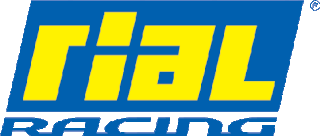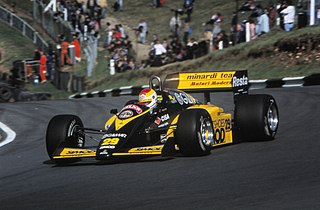
Bertrand Jean Gachot is a French former racing driver. Gachot enjoyed some success in the junior formulae, winning titles in Formula Ford before progressing through Formula 3 and Formula 3000, reaching Formula One in 1989. After winning the 1991 24 Hours of Le Mans, Gachot was sentenced to 18 months in prison for an aggravated assault that had occurred the previous December. He was released after two months on appeal, but his enforced absence enabled Michael Schumacher to make his Grand Prix debut.

Rial is a German producer of light alloy wheels and rims, and was a Formula One constructor competing in the 1988 and 1989 seasons. Founded in the 1970s as a wheel rim producer, the company was bought by Günter Schmid, ex-owner of the ATS wheels company in 1987. Schmid followed the same strategy as he had at ATS, advertising the Rial wheel brand by entering Formula One as a constructor. Rial participated in 32 Grands Prix, entering a total of 48 cars. They scored six championship points, finishing a highest of ninth in the constructors championship in 1988. After leaving Formula One at the end of the 1989 season, the Rial Racing division was closed, and the company did not race again. Rial continues to manufacture wheels and rims from its factory in Fußgönheim.

The Porsche 3512 was a motor racing engine designed by Porsche for use in Formula One in the early 1990s.

The Jordan 191 was a Formula One car designed by Gary Anderson for use by Jordan Grand Prix in its debut season in 1991. Its best finish was in Canada and Mexico, where Andrea de Cesaris drove it to fourth place at both races. Driving the 191 at the 1991 Hungarian Grand Prix, Bertrand Gachot took the fastest lap of the race.

The Tyrrell 018 was a Formula One racing car designed by Harvey Postlethwaite and Jean-Claude Migeot. It was built and raced by Tyrrell Racing. It used a customer Ford DFR engine.

The Brabham BT50 was a Formula One racing car designed by Gordon Murray and powered by a turbo BMW engine. It was raced by the Brabham team, owned by Bernie Ecclestone, during the 1982 Formula One season. Driven by Nelson Piquet and Riccardo Patrese, it made its debut at the South African Grand Prix before being withdrawn for further development of its engine while the team reverted to the previous year's car, the Brabham BT49. On the reintroduction of the BT50, Piquet finished fifth in the Belgian Grand Prix. A few races later he drove it to a win in the Canadian Grand Prix. Later in the year it achieved three more finishes in the points for the team. During the second half of the season, Brabham implemented the strategy of mid-race refueling. This allowed Piquet and Patrese to start the races relatively light and use their reduced weight to gain track position over their competitors before stopping to refuel. The poor reliability of the BT50 meant that they had only a few opportunities to demonstrate the strategy in practice.

The Coloni C4 is a Formula One car designed by Christian Vanderpleyn for the Coloni team for use in the 1991 Formula One season, although it never qualified for a race and was the slowest car in the field.

The Ligier JS33 was a Formula One car used by the Ligier team during the 1989 Formula One season. Its best finish in a race was fifth, at the 1989 Canadian Grand Prix. The JS33 was updated to a 'B' spec for use in the following season, but failed to score any points for the team.

The Dallara F191 was a Formula One car designed by Gian Paolo Dallara and Nigel Cowperthwaite for use by the BMS Scuderia Italia team during the 1991 Formula One season. Its best finish was at the San Marino Grand Prix when JJ Lehto drove it to third place.
The Ligier JS9 was a Formula One racing car manufactured and raced by Ligier during the 1978 Formula One season. Driven by Frenchman Jacques Laffite, its best finish was third (twice).
The Ligier JS21 was a Formula One racing car manufactured and raced by Ligier during the 1983 Formula One season. Powered by a Cosworth V8 engine while the majority of teams used turbo power, the team failed to score any points.

The ATS D6 was a Formula One racing car manufactured and raced by the Team ATS during the 1983 Formula One season. It was powered by the BMW M12/13 4-cylinder turbocharged engine but the team failed to score any points.

The ATS D2 was a Formula One racing car manufactured and raced by the ATS Wheels racing team for most of the 1979 Formula One season. It was powered by a Cosworth DFV V8 engine. Driven by Hans-Joachim Stuck, the D2 failed to finish any races in the points. It was superseded by the ATS D3 from the Austrian Grand Prix.
The ATS D1 was a Formula One racing car manufactured and raced by the ATS Racing Team for the last two races of the 1978 Formula One season. It was powered by a Cosworth DFV V8 engine. Driven by Keke Rosberg, the D1 failed to finish any races in the points.
The Rial ARC1 was a Formula One racing car manufactured and raced by Rial Racing for the 1988 Formula One season. It was powered by a Cosworth DFZ V8 engine. Its best finish was at the 1988 United States Grand Prix when Andrea de Cesaris drove it to fourth place.

The Dallara F189 was a Formula One car designed by Gian Paolo Dallara and Mario Tollentino for use by the BMS Scuderia Italia team during the 1989 Formula One season. Its best finish was achieved by Andrea de Cesaris when he finished third at the Canadian Grand Prix.

The Ligier JS19 was a Formula One racing car manufactured and raced by Équipe Ligier during the 1982 Formula One season. Powered by a Talbot-badged Matra V12 engine, the JS19 was driven by Jacques Laffite and Eddie Cheever.

The Minardi M185 was a Formula One car, designed for Minardi by Giacomo Caliri for use in the 1985 season. For the following season, it was updated to a M185B specification. It was an unreliable car and only finished three races and did not score any points for the team.

The ATS D5 was a Formula One racing car manufactured and raced by the Team ATS racing team during the 1981 and 1982 Formula One seasons. Originally known as the HGS1 in 1981, it was updated for 1982 and designated the D5. It was powered by the Ford-Cosworth DFV V8. The team scored five points with the chassis across the two seasons it was raced.

The March CG891 was a Formula One racing car designed by Adrian Newey and raced by March Racing Team in the 1989 season, driven by Ivan Capelli and Maurício Gugelmin. The car's best result was seventh place, achieved three times by Gugelmin. It also took the fastest lap at the 1989 French Grand Prix.















